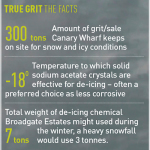 Are you prepared for the thundersnow? All equipped for the frostquake? Freaky winter weather events can cause chaos in central London where space is limited, time is precious and public transport seems to hang by a thread. A bit too much wind, rain or snow and everything grinds to a halt.
Are you prepared for the thundersnow? All equipped for the frostquake? Freaky winter weather events can cause chaos in central London where space is limited, time is precious and public transport seems to hang by a thread. A bit too much wind, rain or snow and everything grinds to a halt.
London’s facilities managers and property managers have been stockpiling grippy rubber mats (for reception areas), salt-and-grit (for pavements) and toilet paper (for obvious reasons) for months. Now, as winter’s final convulsions hit the capital, they are ready for anything.
Broadgate Estates looks after the eponymous 30-acre City of London office scheme, along with buildings at London Bridge, Kings Cross and Paddington. About 40,000 people work in properties it manages.
Managing director Steve Whyman says: “It is all well rehearsed. We do risk assessments on bad weather – all the slips, trips and falls it can mean – and we look at the construction of buildings and the effect of the weight of snow.”
A huge team is mobilised – at Broadgate this means 15 facilities management staff plus up to 100 colleagues working for the tenants. By the time they’ve finished there is not
a marble entrance hall without non-slip mats, a place to stamp snow off your feet, and bags for damp umbrellas.
They will also have checked the gutters, the boilers, and nearby trees, as well as bolting down anything that might suffer from strong winds.
Says Whyman: “London office buildings are a lot more resilient these days, but we still have to be prepared. You need snowplough blades to fit onto machinery – and they are expensive to buy, and expensive to store because they are bulky and you don’t need them for 11 months of the year. Then there’s snow blowers, and grit…”
How about stockpiles of blankets, torches, food and – dare one says it – toilet paper?
 Vaughan Taylor, head of facilities management at DTZ, explains: “Blankets, tinned food – its something we looked at, but we don’t do it now because when we provided that kind of emergency kit the first thing that happened was that the torches started to go missing, then the tinned food went out of date, and soon there was a danger of packs with components missing which would be more danger in an emergency.”
Vaughan Taylor, head of facilities management at DTZ, explains: “Blankets, tinned food – its something we looked at, but we don’t do it now because when we provided that kind of emergency kit the first thing that happened was that the torches started to go missing, then the tinned food went out of date, and soon there was a danger of packs with components missing which would be more danger in an emergency.”
“In the end keeping that sort of stockpile wasn’t very useful. If people can’t get home we put them in hotels, and if we couldn’t do that…then it would be less about sleeping bags, more about warm clothing, extra layers, showers, food. After all, the emergency isn’t likely to last for more than 48 hours.”
As for that other basic necessity, Allison Connick, director of safety and environment at CBRE Asset Services, says not to worry. In the event that you and your team are trapped in an office building due to freak weather, you can visit the bathroom as often as you like.
“It would be awful not to have enough toilet paper, and I guess all our buildings have at least two or three weeks’ supply.
I think I’d be more concerned about running out of coffee,” she says.
How they cope at Canary Wharf
Phil Tweddle, joint managing director at Canary Wharf Management says: “As bad weather comes, we call in our own staff as well as a number of contract companies and start to grit and de-ice the roads and pavements 24/7.
“At peak times there will be 20-25 people across the estate working on snow and ice removal. This becomes a continuous process that increases as soon as the snow starts to fall.”
The operation has an emergency services aura about it, including central briefing and rest room, and arrangements to put snow teams in hotels so they can stay operational all day and all night.
The real worry
There’s one freak event that alarms even normally placid facilities managers – flood.
The Thames Barrier is now 30 years old, but its workload is increasing. It closed for a record 50 times last winter, compared to three or four in most winters, and never more than 20. Speculation about a second Thames Barrier near Dartford is growing, even though engineers say the existing barrier is operating well within capacity.
DTZ head of facilities management Vaughan Taylor says: “You are always worried about floods – even the best roof leaks – and in some modern buildings drains and gullies can’t be cleared regularly because they’re inaccessible. But a flood, whether it comes from the roof or up from the water table or the Thames, is a real concern. Flood is always at the forefront of our mind.”
CBRE director Allison Connick says: “If there’s a tidal surge on the Thames there’s not much we can do about it. It takes a long time to recover from a flood, but we keep sump pumps, hoses and submersible pumps ready.”
EG London: February
• Inside Bishopsgate Goodsyard
• EG London: Market cycles – seizing the moment
• EG London Forum: Migration and EU membership










